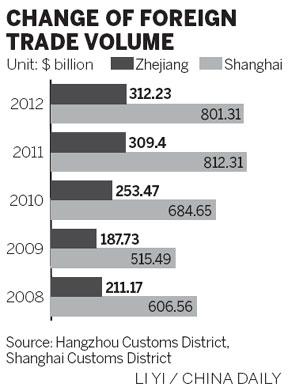Signs of regained strength in East China
Updated: 2013-02-19 07:54
By Shi Jing in Shanghai (China Daily)
|
||||||||
Labor-intensive industries witness strong progress in the region
An unexpected sharp increase in foreign trade in the eastern coastal region in January, though lower than the national average, showed that traditional labor-intensive industries are regaining vitality.
The total import and export value of Shanghai, the region's trade hub, rose by 11.9 percent to reach $68.37 billion in January, according to statistics from the Shanghai Customs District on Sunday. Export value was $43.15 billion, up 6.3 percent.
Figures from the Hangzhou Customs District show the total foreign trade value for Zhejiang province, home to many small and medium-sized companies, reached 186.2 billion yuan ($29.6 billion) in January, up 12.2 percent year-on-year, after adjustment for exchange rate fluctuations. Exports rose 10.3 percent to reach 138.7 billion yuan.
Privately owned companies saw robust growth in January, reaching a total foreign trade value of $18.36 billion, up 20 percent year-on-year, comprising 62 percent of the province's total foreign trade.
China's total foreign trade rose 26.7 percent year-on-year in January to 2.17 trillion yuan, up from 10.2 percent growth in December, according to the General Administration of Customs on Friday. The country's exports rose 25 percent from a year earlier to 1.18 trillion yuan last month.
Li Huiyong, chief analyst at Shanghai-based SWS Research Co Ltd, said: "The export manager index has been picking up for two months. The number of companies that have negative outlooks on exports in the next two or three months have dropped to 40 percent.
"Together with the statistics in the first month, it can be predicted that China's foreign trade will keep growing in the first quarter. As global economic growth is expected to pick up slightly in 2013, exports will in turn rebound."

Traditional labor-intensive industries made significant progress in Zhejiang in January, with the textile industry seeing exports grow by 9.4 percent year-on-year.
The knitting department at Hangzhou Light Industrial Products Arts and Crafts Textiles Import and Export Co Ltd saw its export volume register 23.88 percent year-on-year growth last month, said Yang Huimin, the department manager.
Yang said it is becoming routine to see export figures surge at the beginning of the year. Spring Festival falls in the first two months, and companies will complete all shipments before Lunar New Year's Day.
"The number of orders on hand, the size of each order and the time we take to deliver each order remained the same. However, most textile companies of our type are still faced with many difficulties, as prices of raw materials are rising. We are also losing the competitive edge of lower labor costs, with some of our former European partners turning to factories in Bangladesh, Vietnam and Cambodia," she said.
The ongoing debt crisis in Europe has made the company's business in countries such as the Netherlands and Britain difficult. Therefore, it has been turning more to the United States and is exploring South American countries.
"Former world-leading economies have remained stagnant. Therefore, we have been carefully studying South American markets, which may promise more opportunities. But we should not be over-optimistic about the January numbers. It is more rational to review export volumes in the first three months to predict the trend for the year," Yang said.
Exports of shoes also rose in January, by 13 percent year-on-year. Wu Beilei, owner of Wenzhou Gaotian Shoe Co Ltd, said the company saw growth slightly higher than the authorities' statistics. But she also said it is a type of cyclical increase and even predicted that exports might decline by more than 13 percent in February.
Instead of investing a huge amount in developing trendy shoes, the company focused on functional shoes, mainly targeting the elderly, and retaining its orders.
"At present, we export 70 percent of our products to Japan and the rest to Europe. But both regions lack a vigorous economic rebound," she said. "However, we are not even thinking of exploring any new market. Shoemaking is a very demanding industry. It's better to just let it be."
shijing@chinadaily.com.cn
(China Daily 02/19/2013 page16)

 Li Na on Time cover, makes influential 100 list
Li Na on Time cover, makes influential 100 list
 FBI releases photos of 2 Boston bombings suspects
FBI releases photos of 2 Boston bombings suspects
 World's wackiest hairstyles
World's wackiest hairstyles
 Sandstorms strike Northwest China
Sandstorms strike Northwest China
 Never-seen photos of Madonna on display
Never-seen photos of Madonna on display
 H7N9 outbreak linked to waterfowl migration
H7N9 outbreak linked to waterfowl migration
 Dozens feared dead in Texas plant blast
Dozens feared dead in Texas plant blast
 Venezuelan court rules out manual votes counting
Venezuelan court rules out manual votes counting
Most Viewed
Editor's Picks

|

|

|

|

|

|
Today's Top News
Boston bombing suspect reported cornered on boat
7.0-magnitude quake hits Sichuan
Cross-talk artist helps to spread the word
'Green' awareness levels drop in Beijing
Palace Museum spruces up
First couple on Time's list of most influential
H7N9 flu transmission studied
Trading channels 'need to broaden'
US Weekly

|

|







